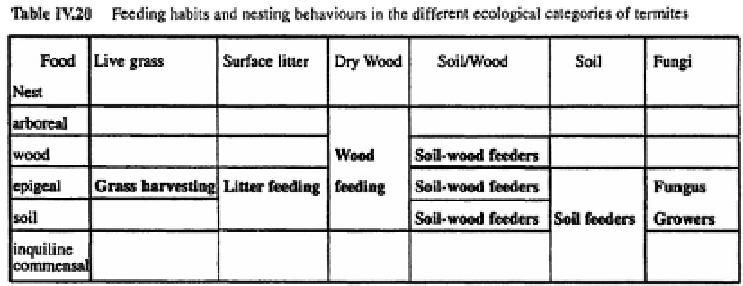Agriculture Reference
In-Depth Information
cultivated fungus. The nest environment creates a habitat for a range of saprophytic and
other micro-organisms and for mycorrhizal fungi and the roots of surrounding plants.
5.2
Subdivisions of the termitosphere
The termitosphere particularly includes systems of nests and galleries, the food resources
exploited and some unusual and highly specific microbial communities. It may be sub-
divided into a number of different but spatially, and even functionally-overlapping
termitospheres, depending on the various ecological strategies represented among the
species present in particular environments. The functional structure of termite communi-
ties is determined by the suite of abiotic and biotic factors described in Chapter III.4.3.2.4.
5.2.1
ECOLOGICAL CATEGORISATION
As discussed in Chapter III.4.3.2.2, termites may be categorised by the materials on
which they feed, where they feed and by their nest types and locations (Abe, 1987).
Many termites are mobile animals and individual colonies may utilise organic resources
distributed across several strata of the biosphere. Species living within trees may either
exploit the resources found there or in the surrounding area, depending on their ecolog-
ical strategies. Conversely, species with subterranean nesting habits may also exploit
underground, surface and arboreal resources. Their considerable mobilities, the broad
dietary ranges of certain species and the capacity of many species to alter their dietary
regimes, together with the lack of correspondence between particular feeding habits and
nest characteristics makes it difficult to erect a general and mutually-exclusive classifi-
cation of termitospheres (Table IV.20).
Despite the above and the considerable variation in dietary items that occurs within
each group (Sleaford
et al.,
1996), the following broad trophic groupings have emerged
as useful at the ecosystem level (Josens, 1983; Eggleton
et al.,
1995):

